

Appreciative Inquiry – putting people at the heart of the future. It is a cyclic, iterative process which means that you continue to capture and use the learning you have as you go forward.
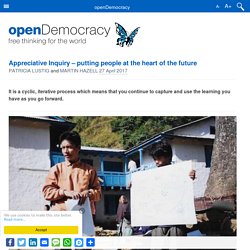
Appreciative Inquiry is a large group change method which is collaborative, generative, responds to the need for everyone to be involved and have a say and includes the future. It was designed to put people at the heart of co-creating their future. It engages all stakeholders in a dialogue about where the energy for the needed change is and how it will be achieved in order to co-create a positive future. Book Review of Strategic Foresight: Learning from the Future – Unlocking Foresight. Strategic Foresight: Learning form the Future by Patricia Lustig, Triarchy Press (2015), 177pp., £15.00, Partly because of the recent number of widely unpredicted events, Foresight (and Forecasting) have been subjected to considerable criticism over the past year.
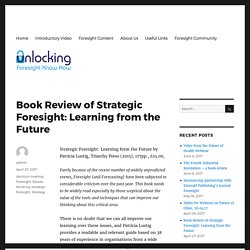
This book needs to be widely read especially by those sceptical about the value of the tools and techniques that can improve our thinking about this critical area. There is no doubt that we can all improve our learning over these issues, and Patricia Lustig provides a readable and relevant guide based on 38 years of experience in organisations from a wide variety of different sectors and organisational size) on how we can all become more effective through greater systematic thinking about the future, as well as exploring the toolkit of a number of different techniques to support this process.
The book should help all decision-makers to more effectively shape the future of their organisations. Five Steps to Develop Your "Foresight Muscles" and Plan For a Successful Future. In today’s constantly changing, interconnected, digitally disrupted, politically challenging, post-Brexit and highly uncertain world, is it a good idea to make a single strategic plan and stick to it regardless?
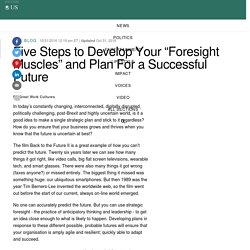
How do you ensure that your business grows and thrives when you know that the future is uncertain at best? The film Back to the Future II is a great example of how you can’t predict the future. Twenty six years later we can see how many things it got right, like video calls, big flat screen televisions, wearable tech, and smart glasses. There were also many things it got wrong (faxes anyone?)
Or missed entirely. No one can accurately predict the future. Strategic foresight helps you imagine a range of possible futures and uses structured frameworks to minimise what you might miss. These five steps will help develop your “foresight muscles”: What is a leader to do? Find the right questions. If I had an hour to solve a problem and my life depended on the solution, I would spend the first 55 minutes determining the proper question to ask for once I know the proper question, I could solve the problem in less than five minutes.
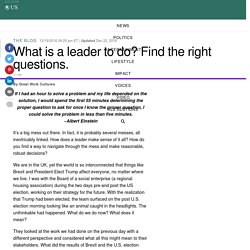
~Albert Einstein It’s a big mess out there. In fact, it is probably several messes, all inextricably linked. How does a leader make sense of it all? How do you find a way to navigate through the mess and make reasonable, robust decisions? We are in the UK, yet the world is so interconnected that things like Brexit and President-Elect Trump affect everyone, no matter where we live.
They looked at the work we had done on the previous day with a different perspective and considered what all this might mean to their stakeholders. TheHRDIRECTOR - The only magazine dedicated to HR Directors. Due diligence for an unsure future Today in your role, you have to think about a range of issues from new and changing legislation and regulations, changing political agendas on issues from zero hours contracts to maternity/paternity leave, accelerating digital disruption that might be changing how your people can or want to work, keeping your workforce fit for purpose and appropriately skilled, to what is happening in the external competitive environment of which your business is a part.
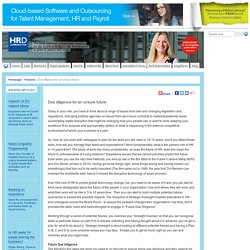
So, how do you work with colleagues to plan for the skills you will need in 15-10 years, and if you attract those skills, how will you manage their talent and expectations? More fundamentally, what is the primary role of HR in 10 years-time? 12 Lustig. Lustig FutureForeignCountry APFCompass 0715 Final. “Strategic Foresight”, by Patricia Lustig. Review by Mick Yates « mick's leadership blog. To quote the author: “You can’t influence the past – it has happened.
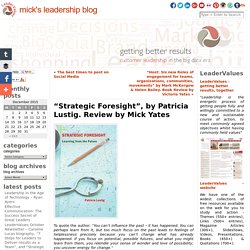
You can perhaps learn from it, but too much focus on the past leads to feelings of helplessness precisely because you can’t change what has already happened. If you focus on potential, possible futures, and what you might learn from them, you rekindle your sense of wonder and love of possibility; you uncover energy for change.“ That is the key premise of this readable and practical book by Patricia Lustig, “Strategic Foresight“.
First, it is action-oriented. Second, Strategic Foresight is open to alternative futures: that is, we work with several futures because we can’t predict the future – and it most certainly won’t be an extrapolation from the past. Third, it is participatory. “A common boardroom feeling is that never before have we needed ‘more hindsight sooner’. The book lays out the needed set of skills and tools used to explore potential futures. Strategic Foresight can be found on Amazon. New book Strategic Foresight by Patricia Lustig from Stroud helps firms look to the future. Future gazing: the benefits of strategic foresight - British Airways Business Life. Business advice and inspiration, insider tips from the world’s top CEOs, analysts and entrepreneurs.
If you are travelling on business today, your choice of destination was likely relatively easy to make.
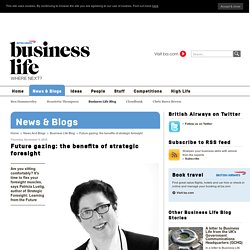
Strategic Foresight: Learning from the Future.